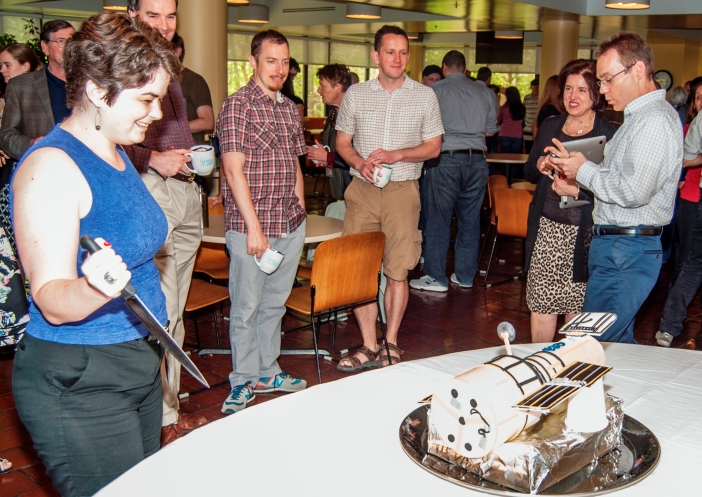The Hubble Space Telescope was launched aboard the aptly named Space Shuttle Discovery, 25 years ago this month. This past week (past month, past year) there have been gobs of events to mark the occasion: special talks, videos, a re-released IMAX movie, panel discussions, banquets, art exhibits, and a video contest. There was even an entire symposium dedicated Hubble’s future through 2020, building on the last 25 years. And so during the symposium, the natural questions amongst astronomers were about its past: where were you when Hubble finally launched? what was your reaction to the whole spherical aberration debacle?
Well. I am currently an astronomer at the Space Telescope Science Institute (STScI) in Baltimore, Maryland, the science home to Hubble. I am on a team that monitors and calibrates two of the instruments installed / repaired in 2009. And I have no memory of the delays to Hubble’s launch, or the eventual April 1990 deployment, or the spherical aberration, or any of it. Because it was twenty-five years ago. And twenty-five years ago I was in kindergarten.
I don’t remember astronomy before Hubble. I vaguely remember pretty astronomy pictures being shown on the news when I was a kid (I can almost hear Tom Brokaw’s voice and the NBC nightly news music playing over the images). I didn’t know it at the time, in 2003, but the first project I worked on as an undergrad relied heavily on Hubble’s ability to exquisitely measure precise positions of the quasars in my sample. My second undergraduate project involved playing with, I mean, manipulating an enormous catalog of hundreds of thousands of galaxies observed with Hubble in the Cosmos survey—a survey that a decade earlier would have been unthinkable. And my first project in grad school (and my first paper!) was based on mining Hubble’s public data archive and re-processing the pictures of dozens of nearby galaxies to extract science the original proposer’s hadn’t thought of. My salary that year was even paid for from a Hubble archival data grant.
So while I intellectually know there was astronomy before the era of Hubble and the other great space observatories, I have a hard time actually imagining it—much, I suspect, in the same way that a child growing up now would have a difficult time imagining life before the ubiquity of email and cell phones. (For the record, I do remember how much fun it was to try to get in touch with someone in an emergency before cell phones.) I’ve always used Hubble as if it has always been there, because for me, it always has been.
But it wasn’t. It took astronomers’ whole careers to create—and maintain—the collaborations between universities, industry, NASA, and ESA that got the “people’s telescope” conceived and off the ground. Yet now it is so easy for astronomers like myself to take the amazingness of having observatories in space for granted.
 One of the reasons it’s been strange having conversations with colleagues about the 25th Hubbleversary is that normally age differences aren’t all that evident. Different people take different career paths, and so age differences don’t translate directly into experience differences—and once you’re all at the forefront of discovery, they matters even less. But at the same time, the success of observatories like Hubble require collaborations in which individual contributions can easily be lost, over times that are long compared to individual careers.
One of the reasons it’s been strange having conversations with colleagues about the 25th Hubbleversary is that normally age differences aren’t all that evident. Different people take different career paths, and so age differences don’t translate directly into experience differences—and once you’re all at the forefront of discovery, they matters even less. But at the same time, the success of observatories like Hubble require collaborations in which individual contributions can easily be lost, over times that are long compared to individual careers.
At STScI, however, it is easy to feel the “institutional” memory and lessons learned from the decades of Hubble. Now, we are steadily ramping up for the James Webb Space Telescope, which will be launched very soon: October 2018!!! We have teams working on pre-flight instrument calibration, figuring out how scheduling will work, and how to maximize the science output of the mission—tasks that thanks to Hubble’s legacy are now almost routine. In a few months, my office will move to a different part of the building, since construction will begin on JWST’s flight operations center where my current office is.
We are already looking beyond JWST: I am part of a team at STScI working on “pre-formulation” science planning of the Wide-Field Infrared Survey Telescope (WFIRST), expected to be launched around 2024. And it’s difficult to go long at STScI without some discussion of an envisioned “high-definition” 10m-class UV-optical-infrared space telescope (I’m drooling at the thought) for sometime in the 2030’s. Each of these three projects (JWST, WFIRST, HDST) are in subsequent stages of their (pre-)infancy.
In the last few months, I have learned more about the decades of ingenuity, sweat, effort, teamwork, and persuasiveness that eventually culminated in the Hubble Space Telescope. And maybe 25 years from now, kids in kindergarten today will be taking each of these future observatories and their amazing data for granted, instead of considering every pixel with giddy excitement.
__________
Molly Peeples is an assistant astronomer at the Space Telescope Science Institute. She mainly works on galaxy evolution. She’s particularly interested in the interplay between galaxies and the intergalactic and circumgalactic media, with a focus on how star formation and stellar deaths affect galaxies and their surroundings. She’s great on Twitter.
_________
Photos: Molly in May 1990 (the one and only time she’s ever been fishing); Molly about to cut the Hubble Space Telescope 25th anniversary chocolate sculpture, April 2015: both courtesy of Molly Peeples
